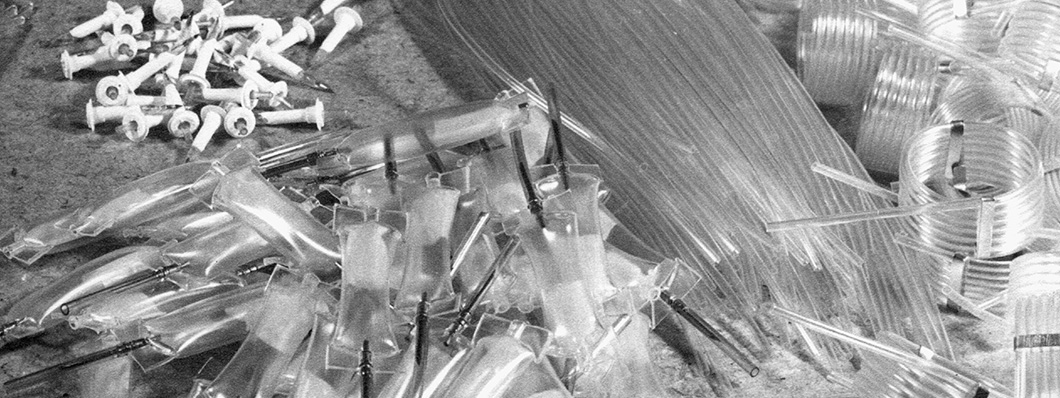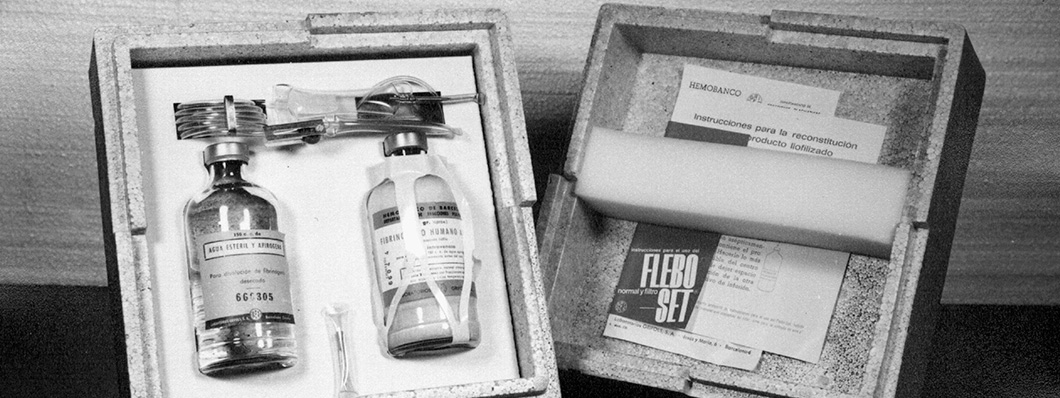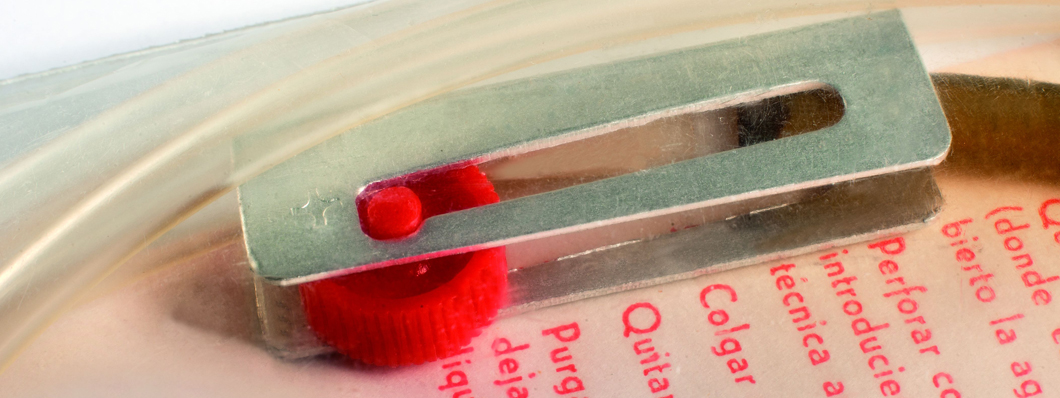Infusion equipment
Needles, handles and adjustable clamps to deliver incremental improvements in intravenous therapy
Technical file
Type of innovation: Instrument
Scope: Hospital Pharmacy
Innovation leader: Grifols i Lucas, Víctor
Year: 1964
Period: 1909-1971
Geographical scope: Spain
Economic impact: High
Level of innovation: Disruptive
Patent: Yes
Interdisciplinary connections: -
Although intravenous therapy is a vital part of modern clinical practice, it wasn't until the 1960s that infusion equipment for use in such therapy was standardized. This development depended, in turn, on advances in the knowledge of vein anatomy and improved materials to puncture veins and infuse drugs and liquids.
Keen to supply hospital products to supplement its parenteral solutions, Grifols improved existing devices and developed new technology to help hospitals offer safe, efficient, high-quality care to their patients.
“The final innovation saw Grifols develop a handle in the form of an adhesive level, die-cut and manufactured from polypropylene … and offered several advantages, including greater safety, easier handling and reduced size.”
Safer needles
Hypodermic needles are a vital element of infusion equipment. The first devices used by Gri-Cel were manufactured for the company in a local workshop. When the workshop closed, Gri-Cel was faced with the possibility of being deprived of a reliable supply of this essential component at a time when importing was not an option. The company decided to bring production in-house, acquiring its former supplier's equipment and hiring its staff.
As a result of this decision, the 1960s saw a number of innovations, with metal protective caps being replaced by plastic ones, along with other design improvements to increase safety and reliability. There were two important innovations, developed and patented by Victor Grifols i Lucas. The first one was to incorporate a groove into the plastic tube that covered the needle, thus allowing the cap to be removed simply by snapping the end off. This action was easier and safer than cutting. And, the second innovation was a patent for a needle for use with injection kits, the design of which ensured a hermetic join between the needle and the drip chamber.

Getting a handle on the problem
The handles or holders used to suspend bottles of parenteral solutions are a key part of the infusion kit, and have developed significantly over time. The first holders were made from aluminum and enclosed the lower part of the bottle, enabling it to be suspended upside down.
These metal handles were replaced by die-cut white or transparent plastic handles, initially manufactured from PVC and later from polypropylene, which was stronger and more resistant to accidental cutting. These, in turn, were replaced by die-cut cardboard holders that were part of the container the bottle was supplied in.
The final innovation saw Grifols develop a handle in the form of an adhesive label, die-cut and manufactured from polypropylene. This was released in the late 1990s and offered several advantages, including greater safety, easier handling and reduced size, with the result that the new handle became the standard in the sector.
The idea for these adhesive labels came from an unusual source. While stopping at a service station on a visit to a trade fair in Chicago, a member of the Grifols delegation saw the system being used to support a bowling ball. If it could be used for such a heavy object, then it could clearly bear the weight of an infusion bottle.

Adjusting the flow
An adjustable clamp integrated into a perfusion kit acts as a key that makes it possible to regulate the pace at which a solution is infused intravenously. Grifols designed its own system, consisting of a V-shaped aluminum clamp, which meant that the infusion tube could be restricted more gradually than was the case with conventional clamps, making it easier to regulate the flow more precisely and to deliver a given number of drips per minute. This design was patented by Grifols in Spain in 1965. The design was subsequently copied, and a plastic version of the clip was patented by a competitor in the USA, the UK and Germany. Only after legal action was taken were these patents annulled.

Landmarks in intravenous therapy
| 1628 | William Harvey discovers blood circulation. |
| 1656 | Christopher Wren uses a goose feather and a pig's bladder to introduce vinegar and opium into a dog's veins. |
| 1667 | Jean B. Denys administers lamb's blood into the veins of three young volunteers. |
| 1818 | James Blundell performs the first successful direct transfusion between humans. |
| 1831 |
French surgeon, Charles Pravaz, invents a syringe with a hollow needle. Thomas Latta uses a solution of salt and water to treat a dehydrated cholera patient. |
| 1843 | Claude Bernard successfully administers sugar solutions into the veins of animals. |
| 1881 | Berlin surgeon, Albert Landerer, uses saline solution for the first time to replace blood lost during an operation. |
| 1887 | The use of glucose solutions to hydrate and feed patients is described. |
| 1923 | Yamakawa administers a solution of fatty emulsion intravenously. |
| 1929 | German doctor, Werner Forssmann, experiments on his own body, introducing a cardiac catheter into an arm vein and using radiological control to guide it to the right ventricle. |
| 1945 | A French surgeon successfully inserts a synthetic central venous catheter. |
| 1967 | Dudrick and Rhoads demonstrate that it is possible to feed a human for long periods of time, exclusively through the use of a venous catheter. |
Bibliography
Grifols i Lucas, V. (1964). Aguja de punción para atravesar el tapón del frasco alimentador de los equipos de inyección gota a gota. (Oficina Española de Patentes y Marcas Patente Nº 108320). Link
Grifols i Lucas, V. (1964). Aguja de punción y goteo para equipos de inyección. (Oficina Española de Patentes y Marcas Patente Nº 104843). Link
Grifols i Lucas, V. (1964). Asa-abrazadera monopieza que facilita la suspensión invertida de frascos para inyección gota a gota. (Oficina Española de Patentes y Marcas PatenteNº 107576). Link
Grifols i Lucas, V. (1964). Funda seccionable por tracción para la protección de elementos clínico-quirúrgicos esterilizados. (Oficina Española de Patentes y Marcas PatenteNº 104842). Link
Grifols i Lucas, V. (1964). Pinza regulable para la estrangulación facultativa de tubos elásticos. (Oficina Española de Patentes y Marcas Patente Nº 108209). Link
Grifols i Lucas, V. (1965). Jaula y asa monopieza para la suspensión invertida de las botellas que alimentan los equipos de inyección gota a gota. (Oficina Española de Patentes y Marcas Patente Nº 115360). Link
Laboratorios Grifols, S.A. (1976). Dispositivo para la suspensión de frascos. (Oficina Española de Patentes y Marcas Patente Nº 224001). Link
Laboratorios Grifols, S.A. (1976). Dispositivo para la suspensión de un frasco en posición invertida. (Oficina Española de Patentes y Marcas Patente Nº 224002). Link
Grifols, S.A. (2011). ¿Y si lo hacemos así? Patentes de Víctor Grífols i Lucas. Barcelona: Grifols, S.A.
Avellà, R., & Miquel, B. (Eds.). (2015). Cuando un sueño se cumple. Crónica ilustrada de 75 años de Grifols. Barcelona: Grupo Grifols, S.A.
Salas Campos, L. (n.d.). Introducción a la terapia intravenosa. Barcelona: IDER CURSOS. Asociación de Equipos de Terapia Intravenosa. Link
Related innovations
INSTRUMENT
The Griflow® device